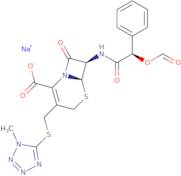
Cefamandole nafate
CAS: 42540-40-9
Ref. 3D-FC19846
| 1g | 136,00 € | ||
| 2g | 172,00 € | ||
| 5g | 279,00 € | ||
| 10g | 436,00 € | ||
| 25g | 801,00 € |
Informação sobre produto
- (6R,7R)-7-[[(2R)-2-(Formyloxy)-2-phenylacetyl]amino]-3-[[(1-methyl-1H-tetrazol-5-yl)thio]methyl]-8-oxo-5-thia-1-azabicyclo[4.2.0]oct -2-ene-2-carboxylic acid sodium saltBergacefCedol
- 5-Thia-1-azabicyclo[4.2.0]oct-2-ene-2-carboxylic acid, 7-[[(2R)-(formyloxy)phenylacetyl]amino]-3-[[(1-methyl-1H-tetrazol-5-yl)thio]methyl]-8-oxo-, monosodium salt, (6R,7R)-
- 5-Thia-1-azabicyclo[4.2.0]oct-2-ene-2-carboxylic acid, 7-[[(2R)-2-(formyloxy)-2-phenylacetyl]amino]-3-[[(1-methyl-1H-tetrazol-5-yl)thio]methyl]-8-oxo-, sodium salt (1:1), (6R,7R)-
- 5-Thia-1-azabicyclo[4.2.0]oct-2-ene-2-carboxylic acid, 7-[[(formyloxy)phenylacetyl]amino]-3-[[(1-methyl-1H-tetrazol-5-yl)thio]methyl]-8-oxo-, monosodium salt, [6R-[6α,7β(R*)]]-
- Bergacef
- Cedol
- Cefam
- Cefamandole Nafate
- Cefamandole formate sodium
- Cefiran
- Ver mais sinónimos
- Cemado
- Cemandil
- Cemandil sodium salt
- Cephamandole nafate
- Kefadol
- Kefandol
- Lampomandol
- Mandokef
- Mandol
- Mandolsan
- NSC 299588
- Neocefal
- O-Formylcefamandole sodium
- Pavecef
- Sodium 7-(<span class="text-smallcaps">D</span>-2-formyloxy-2-phenylacetamido)-3-(1-methyl-1H-tetrazol-5-ylthiomethyl)-3-cephem-4-carboxylate
- Sodium O-formylcefamandole
- sodium (6R,7R)-7-{[(2R)-2-(formyloxy)-2-phenylacetyl]amino}-3-{[(1-methyl-1H-tetrazol-5-yl)sulfanyl]methyl}-8-oxo-5-thia-1-azabicyclo[4.2.0]oct-2-ene-2-carboxylate
- sodium (6R,7R)-7-{[(2S)-2-(formyloxy)-2-phenylacetyl]amino}-3-{[(1-methyl-1H-tetrazol-5-yl)sulfanyl]methyl}-8-oxo-5-thia-1-azabicyclo[4.2.0]oct-2-ene-2-carboxylate
- sodium (6R,7R)-7-{[(formyloxy)(phenyl)acetyl]amino}-3-{[(1-methyl-1H-tetrazol-5-yl)sulfanyl]methyl}-8-oxo-5-thia-1-azabicyclo[4.2.0]oct-2-ene-2-carboxylate
Cefamandole nafate is an antimicrobial agent that is used for the treatment of infectious diseases. It has a broad spectrum of activity and is effective against Gram-positive and Gram-negative bacteria, such as staphylococci, streptococci, and pseudomonads. Cefamandole nafate has been shown to be active against tissue infection caused by E. coli in rats. The mechanism of action involves cell lysis and the formation of sodium carbonate. This reaction takes place when glucose is injected into the animal's intrauterine cavity before injecting cefamandole nafate solution. The chemical reaction between sodium carbonate and glucose produces water, carbon dioxide, sodium bicarbonate, and hydrogen ions. The hydrogen ions react with cefamandole to produce its active form, which then reacts with the bacterial cell wall by disrupting the cell membrane. Cefamandole nafate also inhibits protein synthesis by binding
Propriedades químicas
Consulta técnica sobre: 3D-FC19846 Cefamandole nafate
Se desejar solicitar um orçamento ou fazer uma encomenda, por favor, adicione os produtos ao seu carrinho e depois solicite um orçamento ou encomenda a partir do carrinho. É mais rápido, mais barato e poderá beneficiar-se dos descontos e outras vantagens disponíveis.





